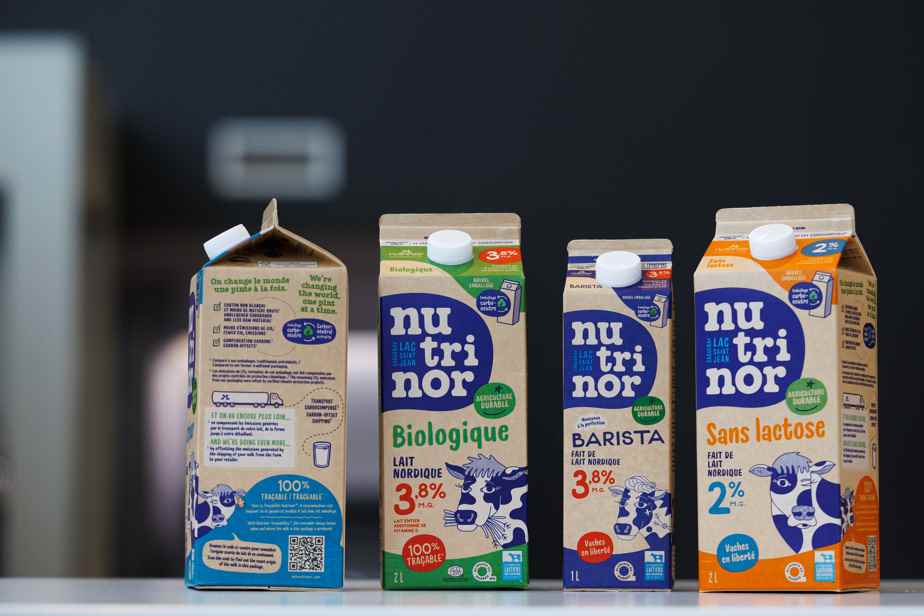Pristine white milk containers will soon be a thing of the past for Nutrinor. The Saguenay–Lac-Saint-Jean dairy cooperative is changing most of its packaging for a more ecological product, a gesture which will however have a low impact, explains an expert.
All types of milk in 1 liter and 2 liter formats bottled since January 10 are in multilayer containers made of non-bleached cardboard, which gives them a natural color.
These new packaging also contain less material than the previous ones – for example, they have no glossy coating on the outside, which gives them a different texture – and require fewer manufacturing steps, which reduces their carbon footprint by half. , supports the company.
Nutrinor says however that it does not know if a life cycle analysis has been carried out to confirm this assertion..
The remaining greenhouse gas (GHG) emissions are offset by the purchase of carbon credits by the manufacturer Elopak, which thus claims that the packaging is carbon neutral.
“The goal is to reduce this compensation and possibly reduce these emissions at source to have carbon neutral packaging that is not partially carbon offset, but the technology has not reached that point,” explained in a interview with The Press Michael Norman, CEO of Nutrinor.

PHOTO PROVIDED BY NUTRINOR
Michael Norman, CEO of Nutrinor
Just because we’ve launched carbon neutral packaging doesn’t mean all the work is done.
Michael Norman, CEO of Nutrinor
The cooperative also says it is working with its supplier to reduce the environmental impact of its other packaging, such as cream cartons or plastic milk bags.
Minimal effect
Laudable as the initiative is, it will have only a minimal effect on the overall environmental impact of milk, underlines engineer Catherine Houssard, research officer at the International Reference Center for the Analysis of the Life and Sustainable Transition (CIRAIG), in Montreal.
“It’s a very small part, it’s a start,” she says, explaining that environmental pollution from fertilizers and pesticides used in the dairy industry is greater than that linked to product packaging. .
“Consumers still believe that environmental issues are tied to packaging,” prompting companies to act on this aspect first, she says.
Nutrinor is well aware of this, assures Michael Norman, recalling that the cooperative adopted in 2020 its “Sustainable agricultural pact”, which aims to put in place better production methods on the farm; all the milk produced by Nutrinor comes from free-range cows, he illustrates.
Where we could act quickly was in terms of packaging; it is one step among many others.
Michael Norman, Nutrinor
“To fight against the big players, you have to be different,” says Mr. Norman, saying he is betting that at the same price – because these changes are made without increasing the prices, he assures -, consumers will favor a more durable product.
The cooperative does not hide the fact that it hopes through these initiatives to increase its place on the shelves outside of Saguenay–Lac-Saint-Jean, where only its organic products are distributed for the moment.
Carbon footprint
Nutrinor also offsets GHG emissions related to the transport of milk, “from farm to market”, which amount to 1,340 tonnes annually.
But this reduction in the carbon footprint of the dairy cooperative, even added to that linked to the change of packaging, is not significant either, indicates Ms.me Houssard.
“When we reduce the carbon footprint [de l’emballage]we reduce less than 3% of the impact”, says the specialist, who adds that transport also represents around 3%.
Basically, it’s 6% of the impact of the milk bottle.
Catherine Houssard, research officer at CIRAIG
That said, Quebec milk has “one of the lowest carbon footprints in the world,” at 0.93 kilograms of carbon dioxide equivalent (kg eq. CO2) per liter, while the world average is around 2 kg eq. CO2she points out.
Adding transport, processing, bottling, delivery and losses, the total carbon footprint reaches 1.3 kg eq. CO2.
Carbon offset criticized
Catherine Houssard believes that the efforts of the dairy industry deserve to be highlighted, but is concerned about claims of carbon neutrality, which are multiplying in trade in general.
“There is no standard, certification available for carbon neutrality”, which opens the door to greenwashing, she explains.
“We find ourselves like 10 years ago with ‘green’ products, where everyone started to make lots of in-house labels, and in the end, we lost consumer confidence”, recalls the researcher specializing in agri-food sector.
She adds that we must first work to reduce GHG emissions to the minimum possible before offsetting those that are impossible to eliminate.
Learn more
-
- 1051
- Number of dairy farmers in the Nutrinor cooperative
Source: Nutrinor
